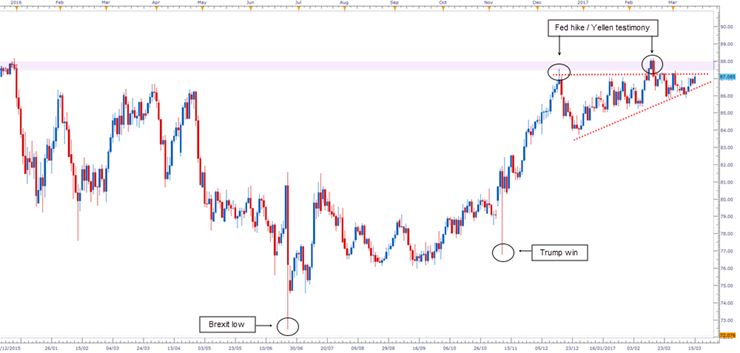We’ve had a stacked calendar of risk events already this week, with wild swings in sterling and oil to kick off proceedings. There have been new calls for referendums, multiple central bank meetings are on the horizon and Dutch elections will highlight if the populist theme will further reverberate into Europe.
Of course, we do have a Bank of Japan meeting tomorrow which is not expected to spring any surprises for the market. There is some noise about a taper discussion in some form – a ‘soft exit’ – but most expect no change to the short-term policy rate or the yield curve control policy. Even if January consumer prices did rise for the first time in over a year, this was due to increasing energy prices. Like most other central banks, the BOJ will look through this transitory effect and sound an upbeat tone on growth instead.
In times like these, we like to take a step back and check the currency pairs which can be a pointer for future events. In which light, AUD/JPY has taken our eye this week, essentially as it’s a great risk ‘barometer’. It is widely known that this pair is a high beta play on the dollar where both AUD and JPY retain a high correlation.
We can see on the daily candle chart some multi-year lows last year around the Brexit vote and Trump victory. The most recent highs in mid December and February match the Fed’s interest rate hike and Yellen’s bullish semi-annual testimony. Prices appear to have now formed a bullish ascending triangle. Price support comes in the form of the ascending trendline drawn from the end of December at 83.44. A flat trendline in the 87.25 area is acting as a strong point of resistance. This zone held prices at previous highs back in 2010, 2011 and 2012 so we can definitely say it has huge importance!

So, it will be fascinating to see where AUD/JPY goes from here with all the above mentioned risk events in the pipeline. Market structure is bullish in the medium-term in AUD/JPY even as recent domestic Australian data has disappointed. However, the strong zone of resistance looms large above any more positive price action and we will leave it to the Fed and global risk appetite in the near-term to determine direction for this pair.
